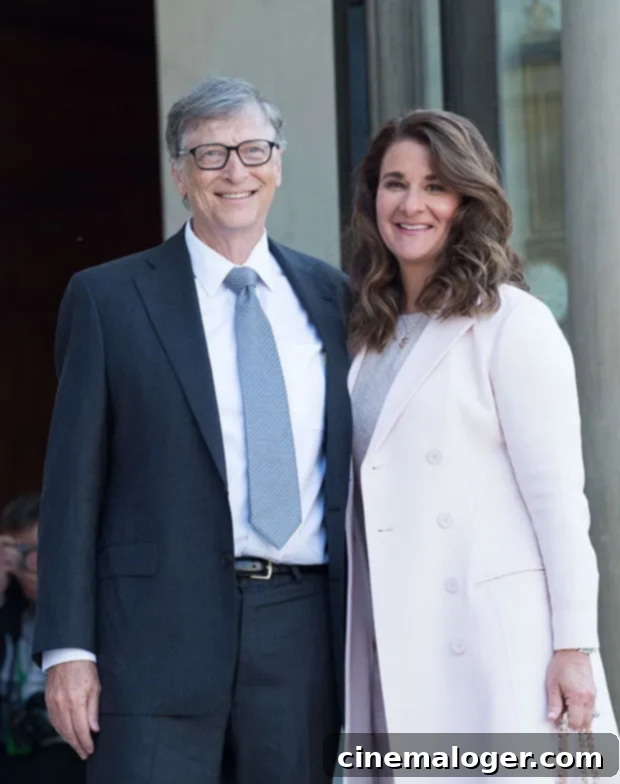Bill and Melinda Gates Divorce: Navigating a $130 Billion Fortune in Washington’s Community Property State
The announcement of Bill and Melinda Gates’ divorce sent shockwaves across the globe, not merely due to the dissolution of a 27-year marriage but also because of the immense financial implications. With Bill Gates being one of the world’s wealthiest individuals, possessing a staggering fortune estimated at $130 billion at the time, the question of asset division became a central point of public and legal discussion. Unlike many high-profile separations, the Gates’ divorce sparked particular interest because the couple reportedly did not have a prenuptial agreement in place, significantly complicating the process of splitting such an unparalleled wealth. This scenario plunges their separation into the intricate world of community property laws, particularly those governing Washington state, where the couple resided.
When such colossal sums of money are involved, the process of divorce is anything but straightforward. The absence of a prenuptial agreement, which typically outlines asset distribution plans before marriage, means that the legal framework of Washington state will play a decisive role. While the specifics of Bill Gates and Melinda Gates‘ divorce proceedings remain highly confidential, legal experts have offered insights into how such a monumental financial split might unfold. Top attorneys suggest that Melinda could potentially walk away with a substantial portion of the marital estate, a figure that demands a nuanced understanding of legal principles rather than simple arithmetic.
Washington State: Understanding Community Property and Equitable Division
Washington, the state where Bill and Melinda Gates lived for their entire marriage, operates under community property laws. This legal classification is crucial to understanding the potential outcome of their divorce. Prominent Seattle family lawyer Brent Bohan explains, “What that means, essentially, is that any property acquired during the course of the marriage is subject to equitable division.” This definition is key because it establishes that all assets accumulated from the day they married in 1994 until their separation are considered marital property, subject to division.
However, it’s vital not to misunderstand the term “equitable.” In the context of Washington’s community property laws, equitable does not automatically translate to an even 50/50 split, especially in cases involving extraordinary wealth. While many people might assume that community property means a precise half-and-half distribution, the courts in Washington retain significant discretion. Bohan clarifies that “equitable” means fair, which might not always mean equal. “There are certain situations where the court may determine, based on principles of equity, that one party should receive more property than the other party,” he noted. This flexibility allows judges to consider various factors, including each spouse’s financial contributions, future earning potential, health, and other circumstances, to arrive at a distribution that they deem just.

The absence of a prenuptial or even a postnuptial agreement further broadens the scope of what the courts can consider. As Bohan puts it, “everything is just wide open.” This means that the entirety of their marital estate, including substantial portions of Bill Gates’ stake in Microsoft and all other investments and assets acquired during their 27-year union, could be subject to this equitable division. This vast scope underscores the complexity and the stakes involved in their divorce proceedings, making it one of the most closely watched financial separations in recent history.
The Complexities of Dividing a Multibillion-Dollar Empire
The sheer scale of the Gates fortune introduces unique challenges that go far beyond typical divorce settlements. When assets amount to hundreds of billions, the practicalities of division become extraordinarily intricate. Bohan provides a hypothetical example: “Let’s, for example, say that [Bill’s] stake in Microsoft is I don’t know, $500 billion. Melinda is entitled to her share. But it may not be possible for them to divide the company 50/50 or even close to that, because it would mean that they’d have to sell off a large portion of their stake and no longer have a majority share.” This highlights a critical point: liquidating large portions of a company’s stock to achieve a precise percentage split can have significant, detrimental impacts on the company’s control, market value, and strategic direction.
In such scenarios, where the marital estate is deeply intertwined with the control of a global corporation, the parties involved, and the courts, must often find creative solutions. Melinda might opt for a settlement that allows Bill to maintain control over his primary business interests, even if it means her receiving a different type of asset allocation. Bohan explains, “Because of that she may decide to say look, in order to maintain control he can keep $300 billion and I’ll take $200 billion.” This illustrates that the definition of “equitable” in high-net-worth divorces becomes highly subjective, influenced by pragmatic considerations related to asset liquidity, market impact, and the long-term interests of all parties involved. Financial experts and valuation specialists would be crucial in assessing the true worth of various assets and structuring a feasible division.
Even if the divorce is amicable, as suggested by Bill and Melinda’s May 3 announcement, the logistical and financial challenges remain formidable. “Generally, it’s really difficult in these types of cases where you’re dealing with billions of dollars to determine what’s fair because everybody’s gonna walk away with more money than they could spend in 100 lifetimes,” Bohan observed. This sentiment underscores the extraordinary nature of their wealth, where conventional notions of financial need or sufficiency no longer apply. The goal shifts from ensuring basic financial security to structuring a future that accounts for immense, continuing prosperity for both individuals.
Lessons from High-Profile Precedents: The Bezos-Scott Divorce
In navigating the complexities of their separation, Bill and Melinda Gates likely looked to precedents set by other high-profile, ultra-wealthy divorces. The split between Jeff Bezos and MacKenzie Scott offers a particularly relevant parallel. In that case, a strategy was employed where one party retained primary control over the core business enterprise, while the other received a substantial settlement primarily in cash and other diversified assets. “It is my understanding Jeff Bezos kept Amazon or he kept control of Amazon and [MacKenzie Scott, his ex-wife] walked with most of the cash,” Bohan noted.

This approach serves as a viable blueprint for the Gates divorce. It allows Bill Gates to remain heavily involved and maintain significant control over his investments and philanthropic endeavors, including Microsoft, while Melinda receives an extensive portfolio of other assets. “So, it could be that they structure some type of deal like that that allows him to be heavily involved in Microsoft while she walks away with a lot of properties,” Bohan speculated. Such a structured settlement would prioritize business stability and personal preferences, acknowledging that a direct 50/50 split of stock might not be the most practical or beneficial outcome for either party, or for the corporations involved.
Beyond Spousal Support: Focusing on Substantial Asset Allocation
Given the magnitude of the wealth involved, the concept of spousal support, or alimony, takes on a different dimension. In most divorce cases, spousal support is awarded to help one spouse maintain a similar standard of living after the separation, especially if there’s a significant disparity in income or earning capacity. However, in a divorce involving billions of dollars, the need for ongoing payments for sustenance becomes moot. Bohan firmly believes Melinda will not need to ask for spousal support, explaining, “She walks away with billions and billions of dollars. There’s no need for him to continue to pay her money.”
Top Seattle divorce attorney Linda K. Ebberson concurs with this assessment, highlighting the legal priorities in such high-asset cases in Washington state. “Spousal support in Washington can be a lot less significant than asset allocation. So [Melinda] might waive a claim for spousal support in exchange for more assets,” she explained. This strategic trade-off is common in ultra-high-net-worth divorces, where a lump-sum distribution of assets is often preferred over continuous payments, providing cleaner financial breaks and greater immediate liquidity for the recipient. The focus shifts entirely to the comprehensive division of the vast marital estate, ensuring both parties are financially independent and secure for many lifetimes.
The Privacy Factor: Why Details Often Remain Confidential
One significant aspect of the Bill and Melinda Gates divorce, common in many high-profile separations, is the intense desire for privacy regarding financial details. While the public remains intensely curious about the specifics of the settlement, Washington state laws often allow for such information to be kept out of public view. Ebberson elaborated, adding that, “with Seattle laws it is possible that we’ll never know the details of the split. It’s quite possible that we’ll never know how the assets were actually divided between them. Bill and Melinda would have a much higher desire, if you will, to keep their financial information private.”
This commitment to privacy is understandable, given the extraordinary wealth and the public scrutiny that accompanies individuals like Bill and Melinda Gates. Disclosing the precise figures and methodologies of their asset division could invite further media attention, speculation, and potential security concerns. Therefore, their legal teams would have likely worked diligently to ensure that the final agreement, once approved by the court, remains sealed or is presented in a manner that protects their personal financial information from the public eye. This desire for discretion prioritizes their personal well-being and allows them to move forward with their individual philanthropic and business endeavors with minimal interference.
The Broader Implications of a Billion-Dollar Divorce
Beyond the immediate financial separation, the divorce of Bill and Melinda Gates carries broader implications. Their shared history as founders of the Bill & Melinda Gates Foundation, one of the world’s most influential philanthropic organizations, adds another layer of complexity. While the divorce agreement primarily focuses on marital assets, the future of their joint philanthropic work and individual contributions to global health and development also comes into focus. Both have expressed commitments to continue their work, but the operational dynamics of the foundation, co-led by them for decades, inevitably face adjustments.
The divorce serves as a powerful reminder of the intricate legal and financial planning required when immense wealth is involved, even for couples who appear to have an amicable separation. It underscores the critical role of prenuptial agreements in providing clarity, but also highlights how robust community property laws, guided by principles of equitable division, can still navigate the complexities when such agreements are absent. The Gates divorce will undoubtedly set new precedents and provide valuable case studies for future high-net-worth divorce proceedings, illustrating the adaptability of legal systems in dealing with unprecedented financial scales.
In conclusion, while the specific financial details of Bill and Melinda Gates’ divorce remain largely confidential, expert analysis suggests a meticulously planned asset division focused on equitable, rather than strictly equal, distribution of their vast marital estate. Guided by Washington’s community property laws and potentially influenced by strategies seen in other billionaire divorces, the settlement likely prioritizes stability of business interests, substantial independent wealth for Melinda, and a strong emphasis on privacy. It’s a testament to the complexities that arise when a quarter-century of partnership and a multi-billion dollar fortune intersect with the legal framework of marital dissolution.
